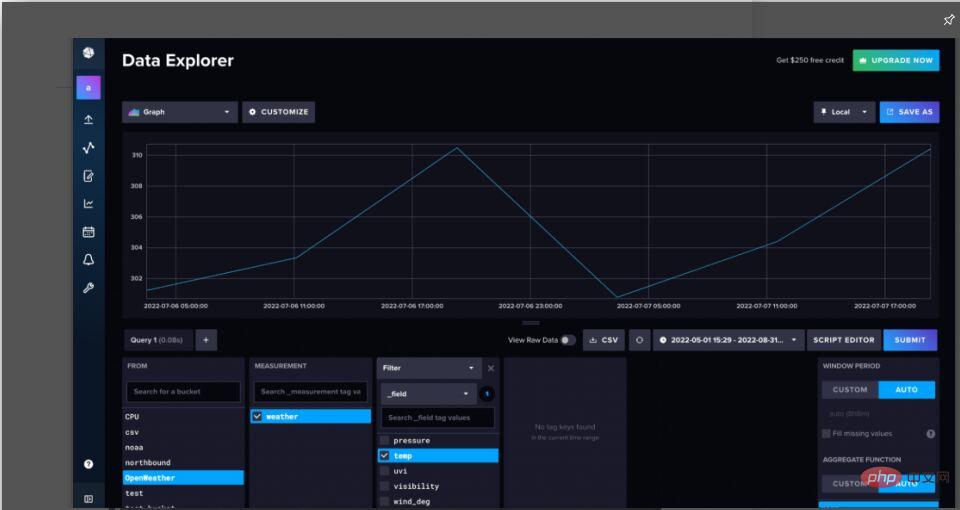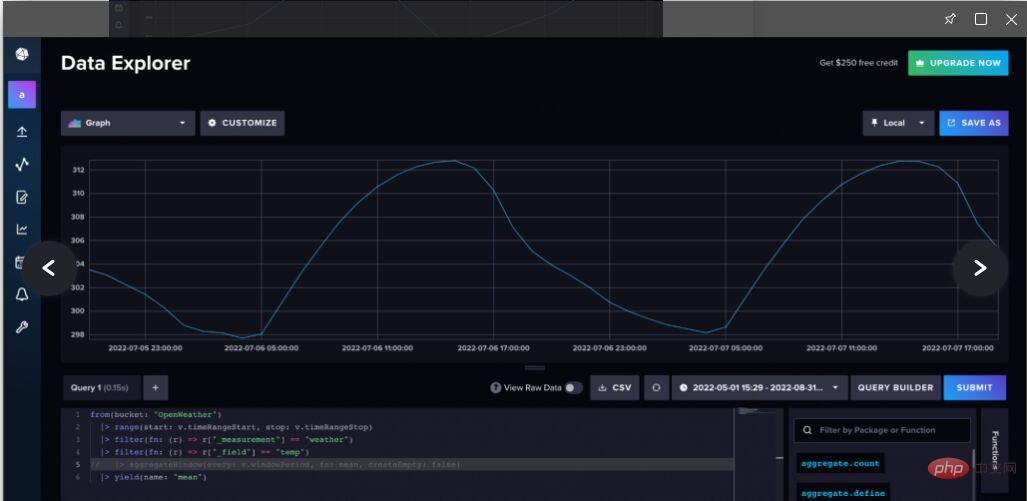用Python獲取和儲存時間序列數據
- WBOYWBOYWBOYWBOYWBOYWBOYWBOYWBOYWBOYWBOYWBOYWBOYWB轉載
- 2023-04-11 19:30:322053瀏覽

譯者| 布加迪
#審查學校| 孫淑娟
本教學將介紹如何使用Python從OpenWeatherMap API取得時間序列數據,並將其轉換成Pandas DataFrame。接下來,我們將使用InfluxDB Python Client,將資料寫入到時間序列資料平台InfluxDB。
我們會將來自API呼叫的JSON回應轉換成Pandas DataFrame,因為這是將資料寫入到InfluxDB的最簡單方法。由於InfluxDB是一個專門建構的資料庫,我們寫入到InfluxDB旨在滿足時間序列資料在攝取方面的高需求。
要求
本教學在透過Homebrew已安裝Python 3的macOS系統上完成。建議安裝額外的工具,例如virtualenv、pyenv或conda-env,以簡化Python和Client的安裝。完整的要求在這裡:
txt influxdb-client=1.30.0 pandas=1.4.3 requests>=2.27.1
本教學也假設您已經建立Free Tier InfluxDB雲端帳戶或正在使用InfluxDB OSS,您也已經:
- ##建立了儲存桶。您可以將儲存桶視為資料庫或InfluxDB中最高層級的資料組織。
- 建立了令牌。
# Get time series data from OpenWeatherMap API
params = {'lat':openWeatherMap_lat, 'lon':openWeatherMap_lon, 'exclude':
"minutely,daily", 'appid':openWeatherMap_token}
r = requests.get(openWeather_url, params = params).json()
hourly = r['hourly']將資料轉換成Pandas DataFrame接下來,將JSON資料轉換成Pandas DataFrame。我們也將時間戳從秒精度的Unix時間戳轉換成日期時間物件。之所以進行這種轉換,是由於InfluxDB寫入方法要求時間戳為日期時間物件格式。接下來,我們將使用這個方法,將資料寫入到InfluxDB。我們也刪除了不想寫入到InfluxDB的欄位。 python # Convert data to Pandas DataFrame and convert timestamp to datetime object df = pd.json_normalize(hourly) df = df.drop(columns=['weather', 'pop']) df['dt'] = pd.to_datetime(df['dt'], unit='s') print(df.head)將Pandas DataFrame寫入到InfluxDB現在為InfluxDB Python客戶端程式庫建立實例,並將DataFrame寫入到InfluxDB。我們指定了測量名稱。測量含有儲存桶中的數據。您可以將其視為InfluxDB的資料組織中僅次於儲存桶的第二高層次結構。 您也可以使用data_frame__tag_columns參數指定要將哪些欄位轉換成標籤。 由於我們沒有將任何欄位指定為標籤,我們的所有欄位都會轉換成InfluxDB中的欄位。標籤用於寫入有關您的時間序列資料的元數據,可用於更有效地查詢資料子集。欄位是您在 InfluxDB中儲存實際時間序列資料的位置。該文件(https://docs.influxdata.com/influxdb/cloud/reference/key-concepts/?utm_source=vendor&utm_medium=referral&utm_campaign=2022-07_spnsr-ctn_obtaining-storing-ts-pything_tns)更詳細地介紹了InfluDBx這些數據概念。
on # Write data to InfluxDB with InfluxDBClient(url=url, token=token, org=org) as client: df = df client.write_api(write_options=SYNCHRONOUS).write(bucket=bucket,record=df, data_frame_measurement_name="weather", data_frame_timestamp_column="dt")完整腳本回顧一下,不妨看看完整的腳本。我們採取以下步驟:1. 導入庫。 2. 收集以下內容:
- InfluxDB儲存桶
- InfluxDB組織
- InfluxDB令牌
- InfluxDB URL
- OpenWeatherMap URL
- OpenWeatherMap 令牌
python
import requests
import influxdb_client
import pandas as pd
from influxdb_client import InfluxDBClient
from influxdb_client.client.write_api import SYNCHRONOUS
bucket = "OpenWeather"
org = "" # or email you used to create your Free Tier
InfluxDB Cloud account
token = "
url = "" # for example,
https://us-west-2-1.aws.cloud2.influxdata.com/
openWeatherMap_token = ""
openWeatherMap_lat = "33.44"
openWeatherMap_lon = "-94.04"
openWeather_url = "https://api.openweathermap.org/data/2.5/onecall"
# Get time series data from OpenWeatherMap API
params = {'lat':openWeatherMap_lat, 'lon':openWeatherMap_lon, 'exclude':
"minutely,daily", 'appid':openWeatherMap_token}
r = requests.get(openWeather_url, params = params).json()
hourly = r['hourly']
# Convert data to Pandas DataFrame and convert timestamp to datetime
object
df = pd.json_normalize(hourly)
df = df.drop(columns=['weather', 'pop'])
df['dt'] = pd.to_datetime(df['dt'], unit='s')
print(df.head)
# Write data to InfluxDB
with InfluxDBClient(url=url, token=token, org=org) as client:
df = df
client.write_api(write_options=SYNCHRONOUS).write(bucket=bucket,record=df,
data_frame_measurement_name="weather",
data_frame_timestamp_column="dt")查詢資料現在,我們已經將資料寫入到InfluxDB,可以使用InfluxDB UI來查詢資料了。導覽至資料資源管理器(從左側導覽列)。使用Query Builder(查詢建構器),選擇想要視覺化的資料和想要為之視覺化的範圍,然後點選「提交」。


圖2. 導覽至腳本編輯器,並取消註解或刪除aggregateWindow()函數,以查看原始天氣資料
結語
但願本文能幫助您充分利用InfluxDB Python Client庫,取得時間序列資料並儲存於InfluxDB中。如果您想進一步了解使用Python Client函式庫從InfluxDB查詢數據,建議您看看這篇文章(https://thenewstack.io/getting-started-with-python-and-influxdb/)。另外值得一提的是,您可以使用Flux從OpenWeatherMap API取得數據,並將其儲存到InfluxDB。如果您使用InfluxDB Cloud,這表示該Flux腳本將被託管並定期執行,因此您可以獲得可靠的天氣資料流,並饋入到執行個體中。想進一步了解如何使用Flux依照使用者定義的時間表來取得天氣數據,請閱讀這篇文章(https://www.influxdata.com/blog/tldr-influxdb-tech-tips-handling-json-objects-mapping- arrays/?utm_source=vendor&utm_medium=referral&utm_campaign=2022-07_spnsr-ctn_obtaining-storing-ts-pything_tns)。
以上是用Python獲取和儲存時間序列數據的詳細內容。更多資訊請關注PHP中文網其他相關文章!

